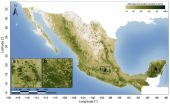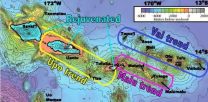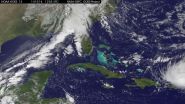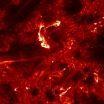(Press-News.org) Cold Spring Harbor, NY – How many times have we seen Superman swoop down from the heavens and rescue a would-be victim from a rapidly oncoming train?
It's a familiar scenario, played out hundreds of times in the movies. But the dramatic scene is reenacted in real life every time a cell divides. In order for division to occur, our genetic material must be faithfully replicated by a highly complicated machine, whose parts are tiny enough to navigate among the strands of the double helix.
The problem is that our DNA is constantly in use, with other molecular machines continually plucking at its strands to gain access to critical genes. In this other process, known as transcription, the letters of our DNA are being copied to form a template that will guide the formation of proteins. But these two copying machines can't occupy the same bit of genetic track at once. Inevitably they will collide – unless a molecular Superman can remove the transcription machinery and save the day.
Cold Spring Harbor Laboratory (CSHL) scientists have found that this molecular Superman exists in the form of a protein known as Dicer. Better known for its role in selectively silencing genes via a process called RNA interference (RNAi), Dicer is now understood to help free transcription machinery from DNA so that replication can occur.
The team, led by Robert Martienssen, a CSHL Professor and Howard Hughes Medical Institute Investigator, concludes that this previously unknown function of Dicer is critical to preserve the integrity of the genome in yeast. They point out that collisions between the replication and transcription machinery lead to massive changes across the genome – changes that are associated with aging and diseases like cancer.
Martienssen and his colleagues previously found that RNAi resolves the conflict between transcription and DNA replication in isolated areas of the genome where genes are being silenced. "When Dicer is mutated, replication stalls and DNA in the region becomes damaged," explains Martienssen. "This was a new role for a protein that we thought functioned solely in RNAi."
In work published today in Cell, Martienssen and his team explored if and how Dicer might function more broadly, across the entire genome. The team, including lead authors Stephane Castel, Ph.D., a graduate of the CSHL Watson School of Biological Sciences, and Jie Ren, Ph.D., a postdoctoral researcher, found that Dicer participates in the release of transcription machinery throughout the genome. "Dicer's function isn't restricted to silenced genes," explains Ren. In fact, it controls the release at hundreds of extremely active genes.
"These are genes that are in constant use by the cell – we call many of them 'housekeeping' genes because they are required for basic survival," says Castel. At any given time, transcription machinery can be found near these genes. Without the help of Dicer, this machinery is headed for an almost certain collision when replication occurs.
Are these collisions really so catastrophic for the cell? The team found that the accidents cause massive segments of DNA to be lost with each cell division. "These chromosome rearrangements, known as genomic instability, are involved in aging and cancer," says Ren. Other groups have shown that mutations in Dicer are similarly associated with an increased risk of tumor formation. The team's discovery may help to explain these observations, according to Martienssen. "It may be that Dicer's role in cancer is to protect the genome by preventing collisions between transcription and replication."
INFORMATION:
This work was supported by the Natural Sciences and Engineering Research Council of Canada, the Spanish Ministerio de Economía y Competitividad, the National Institutes of Health, the Howard Hughes Medical Institute-Gordon and Betty Moore Foundation, as well as a Cashin Scholarship from the Watson School of Biological Sciences and assistance from the Cold Spring Harbor Laboratory Shared Resources, which are funded in part by the Cancer Center Support Grant.
"Dicer Promotes Transcription Termination at Sites of Replication Stress to Maintain Genome Stability" appears online in Cell on October 16, 2014. The authors are: Stephane Castel, Jie Ren, Sonali Bhattacharjee, An-Yun Chang, Mar Sánchez, Alberto Valbuena, Francisco Antequera, and Robert Martienssen. The paper can be obtained online at: http://www.cell.com
About Cold Spring Harbor Laboratory
Founded in 1890, Cold Spring Harbor Laboratory (CSHL) has shaped contemporary biomedical research and education with programs in cancer, neuroscience, plant biology and quantitative biology. CSHL is ranked number one in the world by Thomson Reuters for the impact of its research in molecular biology and genetics. The Laboratory has been home to eight Nobel Prize winners. Today, CSHL's multidisciplinary scientific community is more than 600 researchers and technicians strong and its Meetings & Courses program hosts more than 12,000 scientists from around the world each year to its Long Island campus and its China center. For more information, visit http://www.cshl.edu.
Available for download today, the Woods Hole Research Center (WHRC) and Allianza MREDD+ released the first detailed map of aboveground forest carbon stocks of Mexico. This carbon stock inventory is very valuable for Mexico, as one of the first tropical nations to voluntarily pledge to mitigation actions within the context of the United Nation's Reducing Emissions from Deforestation and forest Degradation (REDD+) program.
The hectare-scale map is the result of a collaboration led by WHRC scientists Josef Kellndorfer and Oliver Cartus with Mexico's National Forestry Commission ...
1. Conventional medical centers may be unable to prevent spread of Ebola
A group of infectious disease experts suggests that conventional U.S. medical centers are unprepared and ill equipped to manage Ebola and a national network of specialized containment and treatment facilities may be needed to reduce the virus' spread, according to an article being published in Annals of Internal Medicine. Despite efforts from the Centers for Disease Control and Prevention (CDC) to prepare hospitals for Ebola, enormous challenges remain. The authors express doubt that conventional ...
A UC Santa Barbara geochemist studying Samoan volcanoes has found evidence of the planet's early formation still trapped inside the Earth. Known as hotspots, volcanic island chains such as Samoa can ancient primordial signatures from the early solar system that have somehow survived billions of years.
Matthew Jackson, an associate professor in UCSB's Department of Earth Science, and colleagues utilized high-precision lead and helium isotope measurements to unravel the chemical composition and geometry of the deep mantle plume feeding Samoa's volcanoes. Their findings ...
VIDEO:
NOAA's GOES-East satellite captured this image of Hurricane Gonzalo off the U.S. East Coast on Oct. 16 at 13:07 UTC (9:07 a.m. EDT).
Click here for more information.
NASA and NOAA satellites have been providing continuous coverage of Hurricane Gonzalo as it moves toward Bermuda. NASA's Terra satellite saw thunderstorms wrapped tightly around the center with large bands of thunderstorms wrapping into it. NOAA's GOES-East satellite provided and "eye-opening" view of Gonzalo, ...
Tropical Storm Ana continued on a path to the Hawaiian Islands as NASA's Terra satellite passed overhead and gathered data on the storm. NOAA's GOES-West satellite data was compiled into a movie that showed the intensification and movement of Ana. Watches are now in effect for Hawaii.
NOAA's Central Pacific Hurricane Center (CPHC) has issued a Tropical Storm Watch for Hawaii County, Hawaii. A tropical storm watch means that tropical storm conditions are possible within the watch area, in this case within 36 to 48 hours. Life-threatening surf and riptide conditions will ...
An international team of scientists has succeeded in explaining the formation and propagation over astronomical distances of jets of matter emitted by young stars—one of the most fascinating mysteries of modern astronomy. Using a patented experimental device and large-scale numerical simulations, the team obtained data consistent with astrophysical observations. The results of this research—just published in the prestigious journal Science—open up new opportunities for studying the role of magnetic fields in astrophysics and thermonuclear fusion. Bruno ...
Why is the Sun's million-degree corona, or outermost atmosphere, so much hotter than the Sun's surface? This question has baffled astronomers for decades. Today, a team led by Paola Testa of the Harvard-Smithsonian Center for Astrophysics (CfA) is presenting new clues to the mystery of coronal heating using observations from the recently launched Interface Region Imaging Spectrograph (IRIS). The team finds that miniature solar flares called "nanoflares" - and the speedy electrons they produce - might partly be the source of that heat, at least in some of the hottest parts ...
Researchers at the University of Connecticut have found a new way to identify protein mutations in cancer cells. The novel method is being used to develop personalized vaccines to treat patients with ovarian cancer.
"This has the potential to dramatically change how we treat cancer," says Dr. Pramod Srivastava, director of the Carole and Ray Neag Comprehensive Cancer Center at UConn Health and one of the principal investigators on the study. "This research will serve as the basis for the first ever genomics-driven personalized medicine clinical trial in immunotherapy ...
Antibiotic-resistant bacteria can share resources to cause chronic infections, Vanderbilt University investigators have discovered. Like the individual members of a gang who might be relatively harmless alone, they turn deadly when they get together with their "friends."
The findings, reported Oct. 8 in Cell Host & Microbe, shed light on a long-standing question in infectious diseases and may inform new treatment strategies, said Eric Skaar, Ph.D., MPH, Ernest W. Goodpasture Professor of Pathology, Microbiology and Immunology.
One way that Staphylococcus aureus and other ...
Using the NASA/ESA Hubble Space Telescope astronomers have made what may be the most reliable distance measurement yet of an object that existed in the Universe's formative years. The galaxy is one of the faintest, smallest and most distant galaxies ever seen and measuring its distance with this accuracy was possible due only to the incredibly detailed mapping of how giant galaxy clusters warp the space-time around them.
Astronomers often use gravitational lensing -- the magnifying power of galaxy clusters -- to find distant galaxies [1]. However, when it comes to the ...





